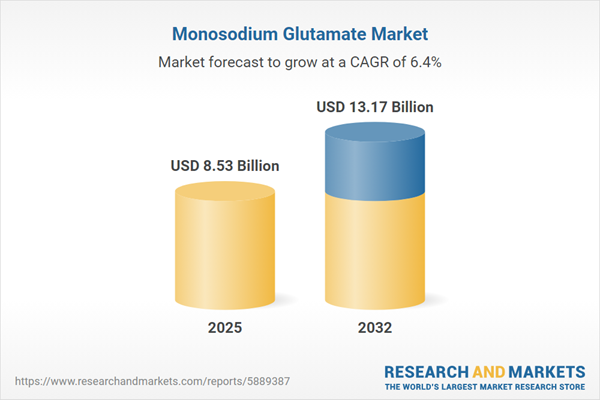Speak directly to the analyst to clarify any post sales queries you may have.
In a changing regulatory and operational landscape, the monosodium glutamate market requires agile strategy and informed leadership. Senior executives must respond to emerging trends and complexity as global demand, compliance requirements, and technology adoption evolve.
Market Snapshot: Monosodium Glutamate Market Size and Growth Prospects
The monosodium glutamate market is valued at USD 8.01 billion for 2024 and forecasted to reach USD 8.53 billion by 2025, based on a compound annual growth rate of 6.41%. Projections show continued expansion to USD 13.17 billion by 2032, driven by strong uptake in both food processing and innovative applications such as animal nutrition and pharmaceuticals. Modern manufacturing networks, integrated supply chains, and robust downstream demand reinforce MSG’s status as a functional additive with multi-sector relevance. Ongoing investments in production capabilities and distribution infrastructure indicate sustained opportunities for value creation.
Scope & Segmentation of the Monosodium Glutamate Market
This comprehensive report delivers actionable segmentation, enabling alignment of strategy across application, sourcing, and regional priorities:
- Application: Explores MSG usage in animal feed—including aquaculture and poultry—processed meats, snacks, soups, seasonings, and pharmaceutical products, offering overview for market targeting and portfolio expansion.
- Form: Examines crystal, liquid, and powder types, outlining their impact on manufacturing workflows and product customization.
- Distribution Channel: Assesses the role of modern retail, hypermarkets, supermarkets, direct sales, e-commerce, traditional retail, convenience outlets, and grocery stores in customer reach and logistics.
- Source: Details chemical synthesis, extraction, and advanced fermentation methods, highlighting sustainability and operational optimization trends.
- Grade: Analyzes feed, food, and pharmaceutical-grade MSG, focusing on regulatory compliance and specialized go-to-market tactics within highly regulated industries.
- Geographic Coverage: Provides regional context on North America (including the United States, Canada, Mexico), Latin America, Europe, Middle East and Africa, and Asia-Pacific with specific attention to China, India, Japan, and Southeast Asia.
- Companies Analyzed: Profiles leading players such as Ajinomoto Co., Inc., Jinan Fufeng Food Co., Ltd., Meihua Holdings Group Co., Ltd., and CJ CheilJedang Corp., examining their roles in innovation and market stability.
Key Takeaways for Decision-Makers
- Fermentation and enzyme technology are increasing production efficiency and advancing sustainability initiatives across diverse operations.
- Rising clean labeling and demand for traceability promote the use of natural and vegetable-based MSG in global supply chains.
- Adoption of blockchain and digital platforms is strengthening supply chain visibility, enhancing responsiveness both in sourcing and end-distribution channels.
- Development of specialty MSG grades is facilitating new market entry, particularly in clinical nutrition and targeted animal feed, creating expanded value streams.
- Divergent regional regulations require flexible compliance frameworks and active engagement with evolving risk management needs throughout the value chain.
Tariff Impact: Implications of New U.S. Trade Policies
Upcoming United States tariffs for 2025 are prompting organizations in the monosodium glutamate sector to reconsider sourcing strategies and production footprints. Many are strengthening regional supply relationships, optimizing operations, and forming joint ventures to maintain supply continuity and protect margins amid changing trade conditions. Leadership must remain proactive in monitoring how these regulations may influence cost structures, import-export flows, and competitive positioning.
Methodology & Data Sources
This analysis draws on primary research with industry experts, sourcing and development leaders. Validation through regulatory documentation and recognized industry databases ensures data integrity and supports insight-driven decision-making for senior executives.
Why This Report Matters
- Provides a reliable benchmarking reference for evaluating current strategies versus emerging innovation and compliance trends worldwide.
- Enables the development of targeted sourcing approaches and product initiatives tailored to regional and application-specific demands.
- Equips business leaders to anticipate shifts in market opportunity while managing operational risk with greater agility.
Conclusion
Equipped with timely insights from this report, leaders can adapt to evolving technologies, changing regulatory demands, and rising stakeholder expectations to create value and strengthen resilience in the monosodium glutamate market.
Additional Product Information:
- Purchase of this report includes 1 year online access with quarterly updates.
- This report can be updated on request. Please contact our Customer Experience team using the Ask a Question widget on our website.
Table of Contents
3. Executive Summary
4. Market Overview
7. Cumulative Impact of Artificial Intelligence 2025
List of Figures
Samples

LOADING...
Companies Mentioned
The key companies profiled in this Monosodium Glutamate market report include:- Ajinomoto Co., Inc.
- Jinan Fufeng Food Co., Ltd.
- Meihua Holdings Group Co., Ltd.
- CJ CheilJedang Corp.
- Global Bio-Chem Technology Group Company Limited
- Kyowa Hakko Bio Co., Ltd.
- Hebei Zhongxing Pharmaceutical Co., Ltd.
- Hebei Yatai Pharmaceutical Co., Ltd.
- Anhui Jinhe Industrial Group Co., Ltd.
- Wuhan Fugen Bio-Chemical Co., Ltd.
Table Information
| Report Attribute | Details |
|---|---|
| No. of Pages | 183 |
| Published | October 2025 |
| Forecast Period | 2025 - 2032 |
| Estimated Market Value ( USD | $ 8.53 Billion |
| Forecasted Market Value ( USD | $ 13.17 Billion |
| Compound Annual Growth Rate | 6.4% |
| Regions Covered | Global |
| No. of Companies Mentioned | 11 |









